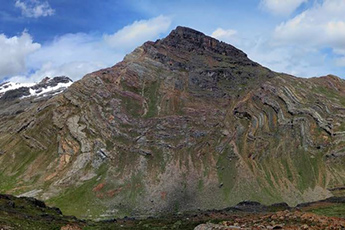Community Vision Document for Research in Tectonics Submitted to NSF
November 14, 2017
A new community-sourced vision document highlighting challenges and opportunities for future research in tectonics was presented to the National Science Foundation.
Professor of Geology Keith Klepeis of the University of Vermont and Associate Professor of Earth and Space Sciences Katharine Huntington of the University of Washington served as co-chairs of the writing committee for the report, entitled "Challenges & Opportunities for Research in Tectonics: Understanding deformation & the processes that link Earth system from geologic to human time." The press release details the extensive community-driven process.
The report, funded by the Division of Earth Sciences, identifies five grand challenge areas for advances in the field of tectonics, prioritizes the resources and partnerships needed to make progress, and envisions a detailed method to build and strengthen the tectonics community while maximizing its educational and societal impacts.
The five grand challenges identified for research in tectonics are:
1. Understanding planetary evolution in four dimensions
2. Understanding the dynamic interactions among Earth-surface processes and tectonics
3. Understanding variations in rheology throughout the lithosphere
4. Understanding fault zone behavior from Earth’s surface to the base of the lithosphere
5. Meeting societal needs while advancing research in structural geology and plate tectonics
The document is based on a year-and-a-half of community discussion and data gathering, including contributions of over 90 scientists at a three-day workshop on the Future of Tectonics in Madison, Wis., in May 2016. Extensive community input was gathered before, during and after that workshop, including town hall meetings at national conferences, online surveys and focus group discussions.
This data-gathering effort took over 18 months to complete. Huntington and Klepeis sought opinions not just from academics but from a wide range of public school educators, researchers and industry scientists.
The final report is available at: https://sgtfuturedirections.files.wordpress.com/2017/09/tectonics2017_forcommentlowres.pdf.
The U.S. National Science Foundation propels the nation forward by advancing fundamental research in all fields of science and engineering. NSF supports research and people by providing facilities, instruments and funding to support their ingenuity and sustain the U.S. as a global leader in research and innovation. With a fiscal year 2023 budget of $9.5 billion, NSF funds reach all 50 states through grants to nearly 2,000 colleges, universities and institutions. Each year, NSF receives more than 40,000 competitive proposals and makes about 11,000 new awards. Those awards include support for cooperative research with industry, Arctic and Antarctic research and operations, and U.S. participation in international scientific efforts.
Connect with us online
NSF website: nsf.gov
NSF News: nsf.gov/news
For News Media: nsf.gov/news/newsroom
Statistics: nsf.gov/statistics/
Awards database: nsf.gov/awardsearch/
Follow us on social
Twitter: twitter.com/NSF
Facebook: facebook.com/US.NSF
Instagram: instagram.com/nsfgov

